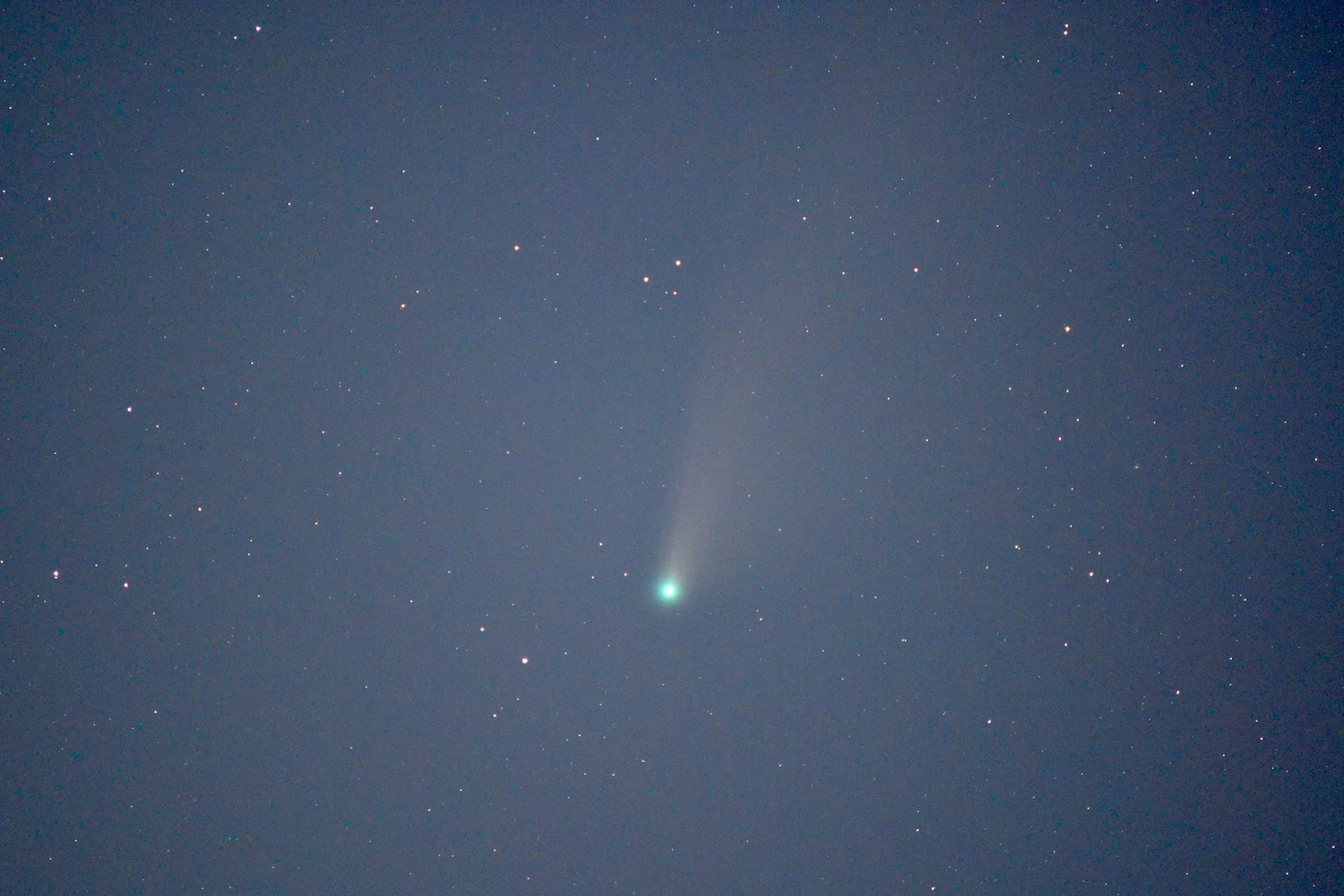Contact NFC
All images shown on this page were acquired using the NFC Observatory located in Jefferson County, Florida.
The Moon
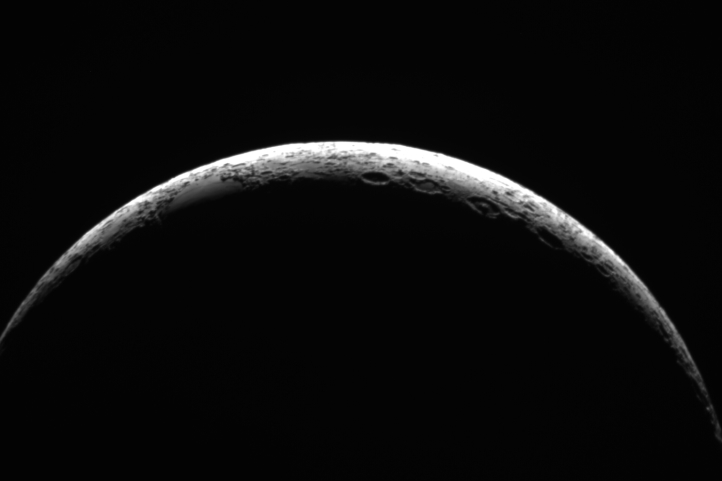
Crescent Moon 1.7 days after New Moon. 4 % of the Moon's disk was illuminated by the Sun on November 3, 2016. (Photography by Dr. G. Maresch)
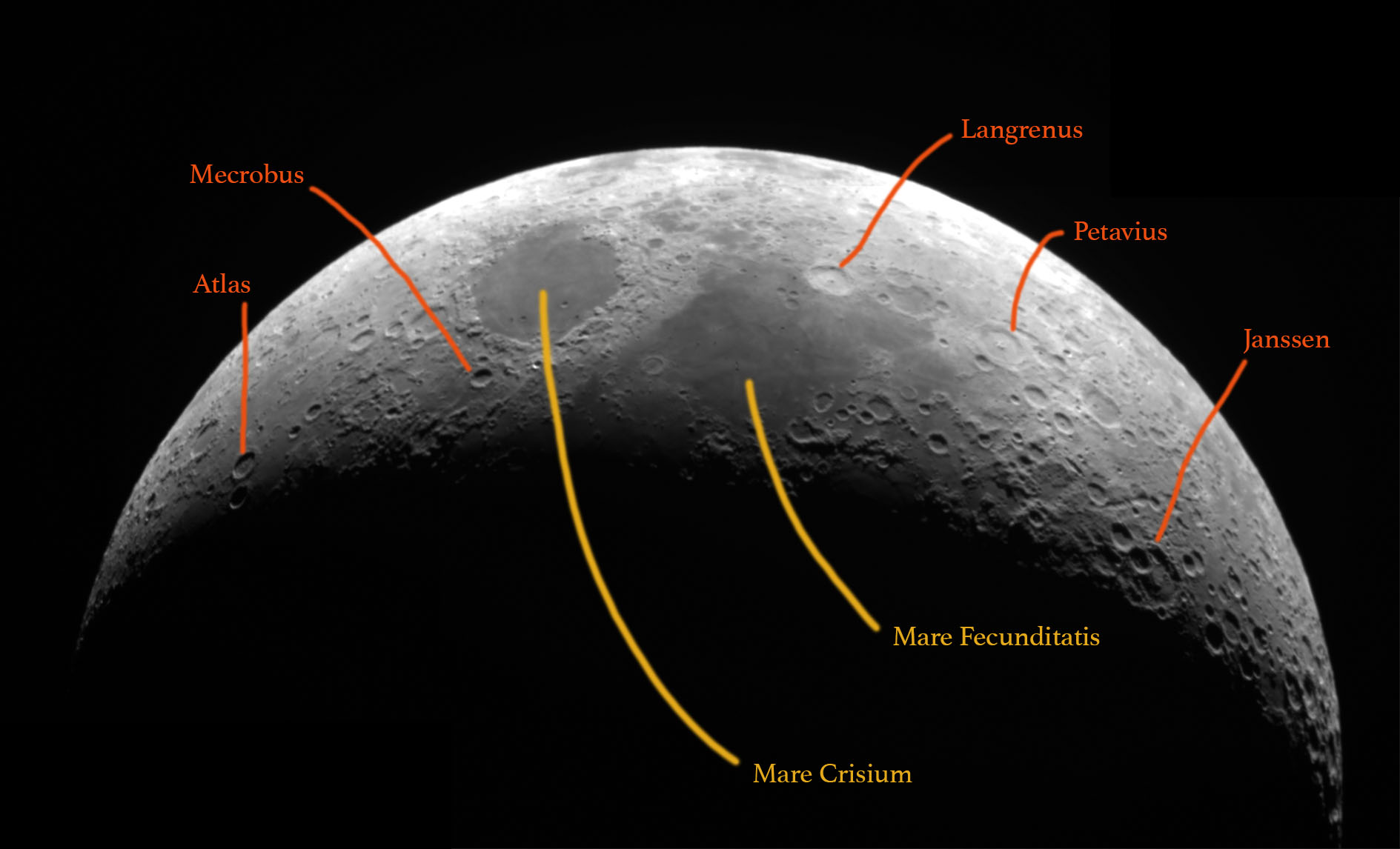
4.4 day old crescent Moon. Mosaic from main instrument camera images taken 07/27/2017 22:30 EDT through SII filter. North is left, South is right, the Eastern side of the Moon is at the top. (Photography by Dr. G. Maresch)
The two major features are Mare Crisium (the Sea of Crisis) and Mare Fecundidatis (the Sea of Fertility), large basaltic plains which appear darker than other materials on the Moon. A few prominent craters have been labeled in the image. A small distance East (above) crater Janssen, lies an area appearing as a deep "scratch". It is the second largest valley on the near side of the moon called Vallis Rheita with a length of 445 km (280 mi). At its maximum extent this valley has a width of about 30 km (19 mi), but it narrows to 10 km (6 mi) at the southeastern extreme.
Note, crater Janssen is the larger, ancient crater appearing worn by bombardment during the millennia, containing another, younger crater in its entirety. The younger crater's name is Fabricius.
The "modern" system of lunar nomenclature was introduced in 1651 by Giovanni Battista Riccioli. Together with Francesco Maria Grimaldi, who drew Riccioli's maps, they named maria (seas), lacus (lakes), sinus (bays), valles (valleys), and paludes (marshes) in Latin, the internationally accepted scientific language of their time, and craters for significant astronomers, grouping them by philosophies and time periods.
Brain teaser for the advanced reader: The two images above represent a textbook example of the Moon's libration. Can you find the same craters in both images? What seems to be odd about that?
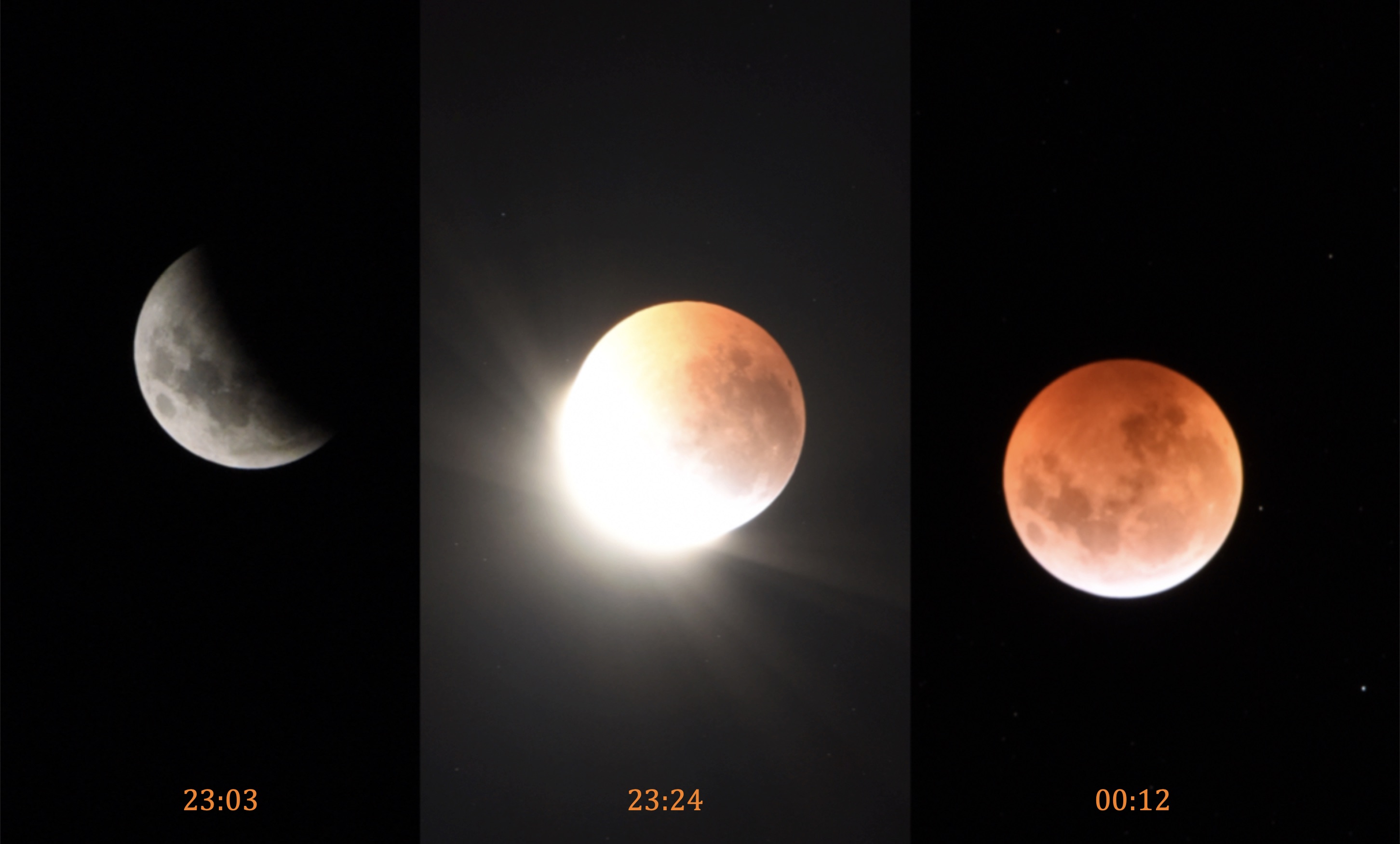
Total lunar eclipse 01/21/2019, the super blood wolf moon eclipse. It belongs to Saros cycle 134. Partial eclipse began 01/20/2019 at 22:33 Eastern Standard Time. Totality lasted from 23:41 to 00:43. Finally the partial period ended 01:50 EST. Photos taken with the wide-field camera on the telescope of the NFC Observatory. The next total lunar eclipse visible from the United States will occur May 16, 2022 (after one on May 26, 2021, which occurs under less favorable conditions).
Asteroid 4 Vesta
Recently, some students looked at asteroid 4 Vesta, one of the largest objects in the asteroid belt with a mean diameter of 525 km (326 miles). The two images shown below as inserts were taken on two consecutive nights. Notice, the background stars are different. The brightest object in the middle (of the insets) is Vesta.
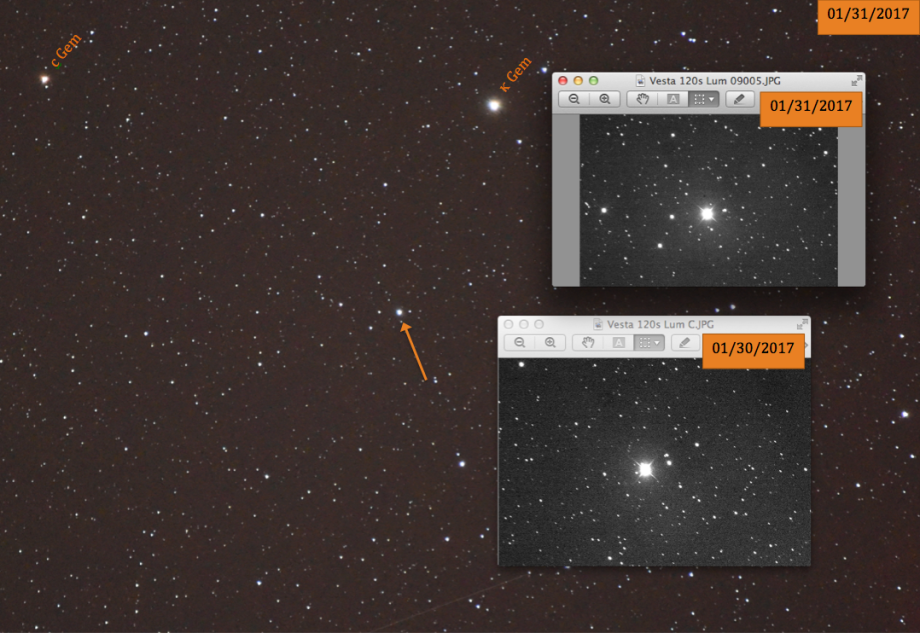
The large image covers a larger area in the sky. Taken during the second night, this image shows Vesta located at the tip of the orange arrow. By comparing the background stars, we find the location on the previous night is at the tail of the arrow. In all three images, North is left, and West is up.
Currently, Vesta is the brightest asteroid visible from Earth. Its maximum distance from the Sun is slightly greater than the minimum distance of Ceres from the Sun, though its orbit lies entirely within that of Ceres. Ceres is a dwarf planet and the largest object in the asteroid belt [freely cited after "4 Vesta" on Wikipedia, much more information is available there].
Astrometry
Imagine an astronomy lab with the goal to determine the distance of Vesta from Earth using data from the NFC Observatory. From the two images acquired by the NAO the following two positions have been determined [the first two data rows are used for the calculation below]:
Date Time RA (J2000) Dec hour angle λ / o β / o
01/30/2017 22:43 EST 7:47:21 24o36'13.5" 23:01:30 114.28004 3.40033
01/31/2017 21:51 EST 7:46:24 24o40'52.6" 22:13:58 114.05337 3.43793
02/24/2017 22:55 EST 7:28:12.8 26o08'10" 109.75415 4.19868
02/25/2017 20:48 EST 7:30:17.6 26o15'33" 110.19796 4.39097
The apparent motion of the asteroid through the sky is determined by two factors: a) the annual motion of the Earth in its orbit around the Sun, and b) the actual motion of Vesta in its orbit around the Sun. For a first order approach we neglect the 7.14o inclination of the asteroid's orbit with respect to the ecliptic. Also, for the small distance moved during the period of almost one day, we can use ΔRA = -57 sec = -855" and ΔDec = +279.1" and the Pythagorean Theorem to determine the apparent distance Δd = 899.4" (note, " means arcseconds), traveled in Δt = 23.63333 h = 0.9847222 days. Then Δd/Δt is the apparent instantaneous velocity 913.354"/d = 38.0564"/h in a WNW direction as indicated by the orange arrow in the large image [Only January data were used from table above].
We observe that ΔRA is negative because the Earth in its orbit is faster than the asteroid, which was in January 2017 opposite of the Sun as seen from Earth. In other words, the Earth currently passes the asteroid; Vesta shows retrograde motion. We also see that ΔDec is rather large and positive. Depending on Vesta's exact position in the ecliptic and the location of the ascending node, a substantial change in declination is not surprising. It will take more measurements than the ones shown above to determine quantitatively the effect of it's inclination. From the ecliptic coordinates (λ, β) converted with the current orbital inclination of the Earth of ε = 23.43706o [from Wikipedia], we obtain Δλ = -0.22667o and Δβ = +0.03760o, a retrograde motion in geocentric ecliptic longitude of -13.60' and northerly motion in geocentric ecliptic latitude of 2.26' during January 31st, 2017.
Comet NEOWISE
During July and August 2020 comet C/2020 F3 (NEOWISE) zipped through the inner solar system. The camera on NFC's flagship telescope at the Astronomical Observatory took the above image on 07/27/2020 of the three miles wide visitor from the outer regions of the solar system when it was 108 million km (68 million miles) from Earth right after its closest approach at 103.5 million km (65 million miles) on July 23rd. NEOWISE is now heading out way past the orbits of Neptune and Pluto. The comet is expected to return in 6,770 years.
Comet Catalina
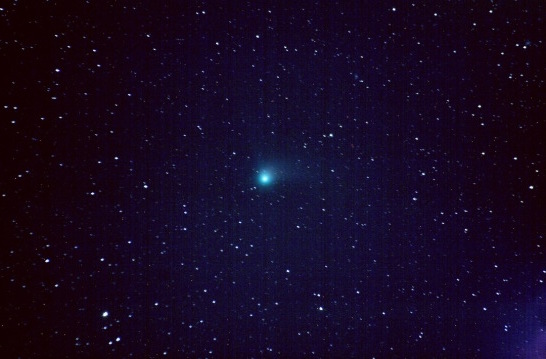
In December 2015 / January 2016 Comet Catalina visited the inner solar system, and Earth's inhabitants of the Northern hemisphere were fortunate to be able to observe it. DSLR camera stack of 15 x 30 sec exposures taken on 01/12/2016 05:27 EST. (Photography by Dr. G. Maresch)
Globular Cluster Omega Centauri
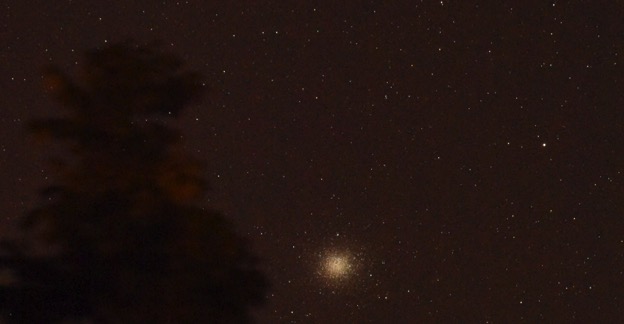
Omega Centauri is a globular cluster in the constellation of Centaurus. Located at a distance of 16,000 light-years, the star cluster is the largest globular cluster in our neighborhood of the Milky Way Galaxy. It contains approximately ten million stars. Photo from the wide-field camera at the NAO on 05/14/2017. (Photography by Dr. G. Maresch)
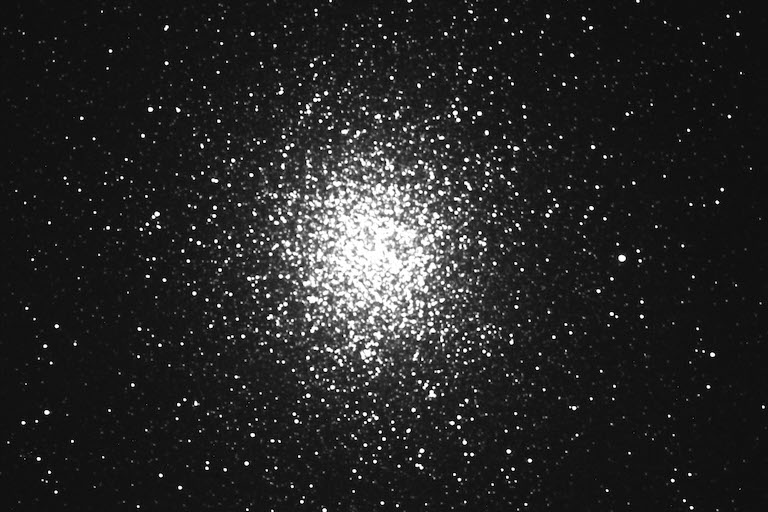
Omega Centauri on the same night, same telescope, but different (SBIG) camera, 60 sec exposure through luminosity filter. (Photography by Dr. G. Maresch)
The Orion Nebula
With our bare eyes, we almost can see the Orion Nebula, M42, as a foggy patch. Certainly with binoculars, when looking at what seems the star in the middle of Orion's sword, we recognize this object is not a star. It is the largest star manufacturing facility in our galactic neighborhood.
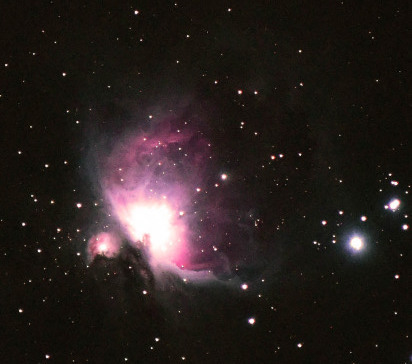
M42 is located at a distance of 1344 light years and estimated to be 24 light years across with about the mass 2000 times the mass of our Sun. The nebula contains a young open star cluster, known as the Trapezium due to the asterism of its primary four stars.
The entirety of the Orion Nebula extends across a 1o region of the sky, and includes neutral clouds of gas and dust, associations of stars, ionized volumes of gas, and reflection nebulae. M42 is part of a much larger nebula that is known as the Orion Molecular Cloud Complex, which includes Barnard's Loop, the Horsehead Nebula, M43, M78, and the Flame Nebula. An ionized HII region is roughly centered on θ Orionis. [freely cited from Wikipedia "Messier 42"]
NAO's image above was taken on 12/26/2016 21:30 EST and includes M43, De Mairan's Nebula, to the upper left in this image. M43 is separated from M42 by a large, dark dust lane. John Herschel described it as "remarkable, round, with a tail". As a reference, the bright star left at the bottom is ι Orionis with a magnitude of 2.77m [DSLR camera with effective f = 450 mm at f/5.6 and ISO 6400, stack of 20 x 20 sec exposures processed with PhotoShop]. (Photography by Dr. G. Maresch)
The Horsehead Nebula
The Horsehead Nebula and NGC 2023, an emission nebula, both close by Alnitak, the leftmost star in the belt of Orion.
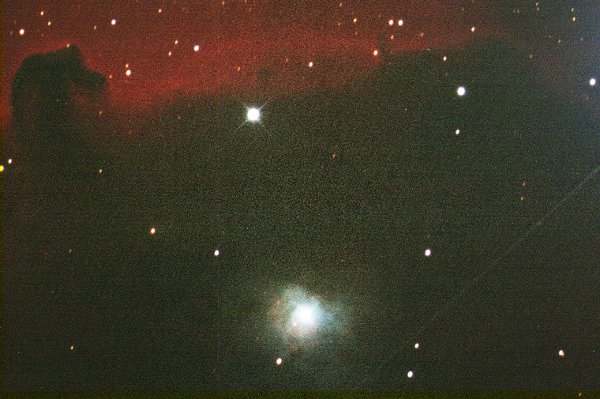
SBIG camera, RGB each exposed for 120 sec, 02/07/2016. This image was created with the help of ESA/ESO/NASA PhotoShop FITS Liberator. Project Lead: Lars Lindberg Christensen. (A satellite crossed the field of view of the camera and left the straight track visible in the bottom right corner of the image.) (Photography by Dr. G. Maresch)
Trifid Nebula
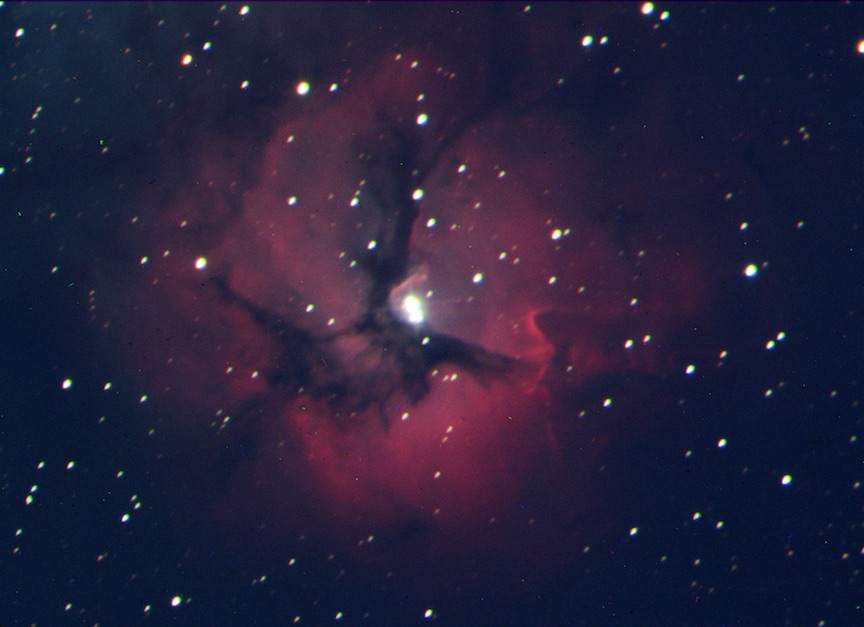
M20, the Trifid Nebula in Sagittarius. A cloud of glowing hydrogen together with a reflection nebula, an open star cluster, and a dark nebula - the apparent gaps within the emission nebula that cause the trifurcated appearance, which gave the object its name. RGB filtered images from the SBIG camera of the NAO, 300 sec exposure time each. This image was acquired on June 22, 2017 and created with the help of the ESA/ESO/NASA FITS Liberator and PhotoShop CC. (Photography by Dr. G. Maresch)
Dumbbell Nebula
M27 is a planetary nebula in the constellation Vulpecula, the little fox, at a distance of about 1,400 light-years. Vulpecula, and with it the Dumbbell Nebula are located in the middle of the Summer Triangle, an asterism consisting of the three bright stars Deneb, Vega, and Altair.
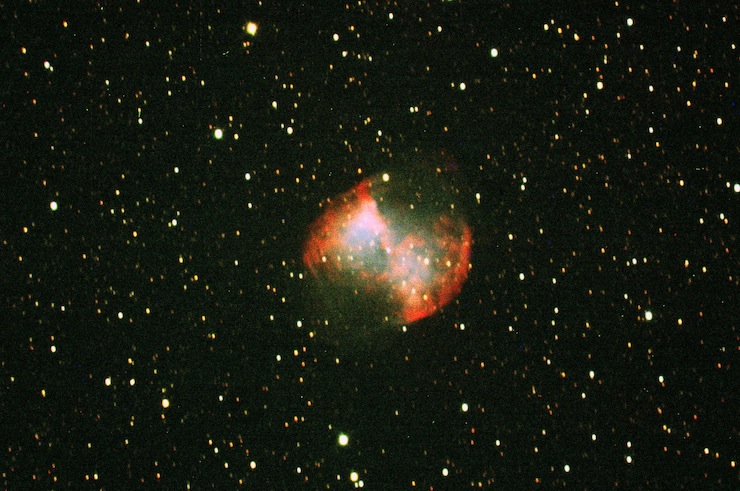
SBIG camera, each RGB 2 min exposure, 10/31/2016. This image was created with the help of ESA/ESO/NASA PhotoShop FITS Liberator. Project Lead: Lars Lindberg Christensen. (Photography by Dr. G. Maresch)
Andromeda Galaxy
Andromeda Galaxy M31 with satellite galaxies M32 and M110, 2.5 million light-years from Earth.
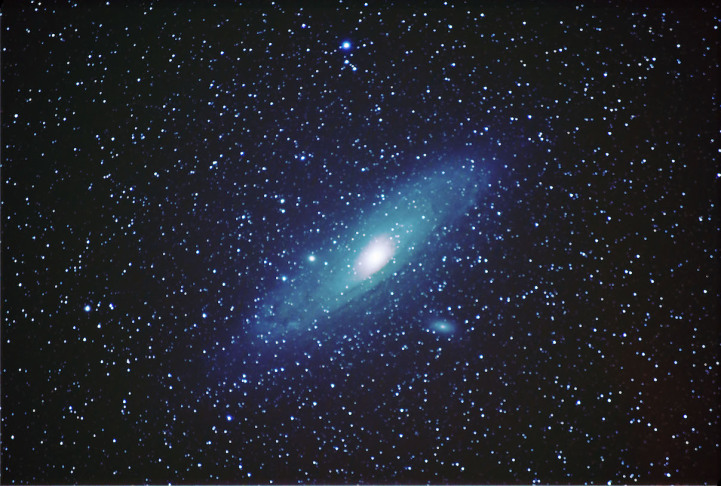
New DSLR camera, effective focal length f = 450 mm, stack of 22 images, each with one minute exposure, 11/21/2016. (Photography by Dr. G. Maresch)
Sculptor Galaxy
Sculptor Galaxy NGC 253, a spiral galaxy 11 million light-years from Earth.
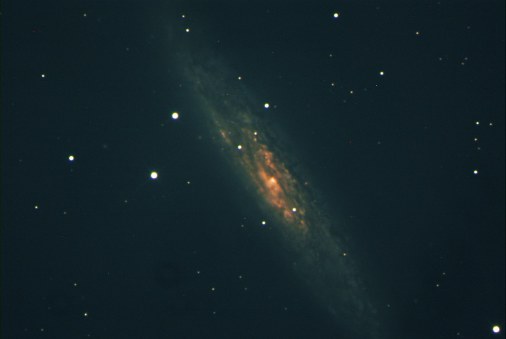
SBIG camera, LRGB H-alpha 120 sec each. 11/19/2016 00:14 EST (Photography by Dr. G. Maresch)
Triangulum Galaxy
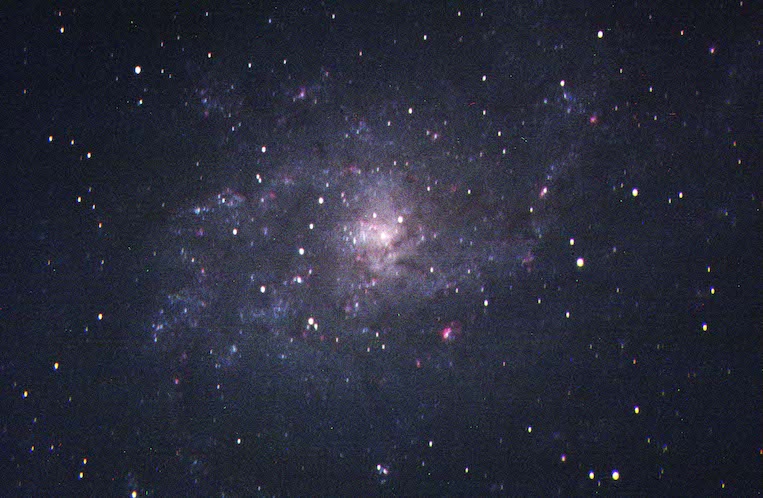
M33, the Triangulum Galaxy is a spiral galaxy approximately 3 million light-years from Earth in the constellation Triangulum. RGB and H-alpha image obtained on 02/16/2017 and processed by the Astronomy Club in the Spring Semester 2017.
Supernova in NGC 6946
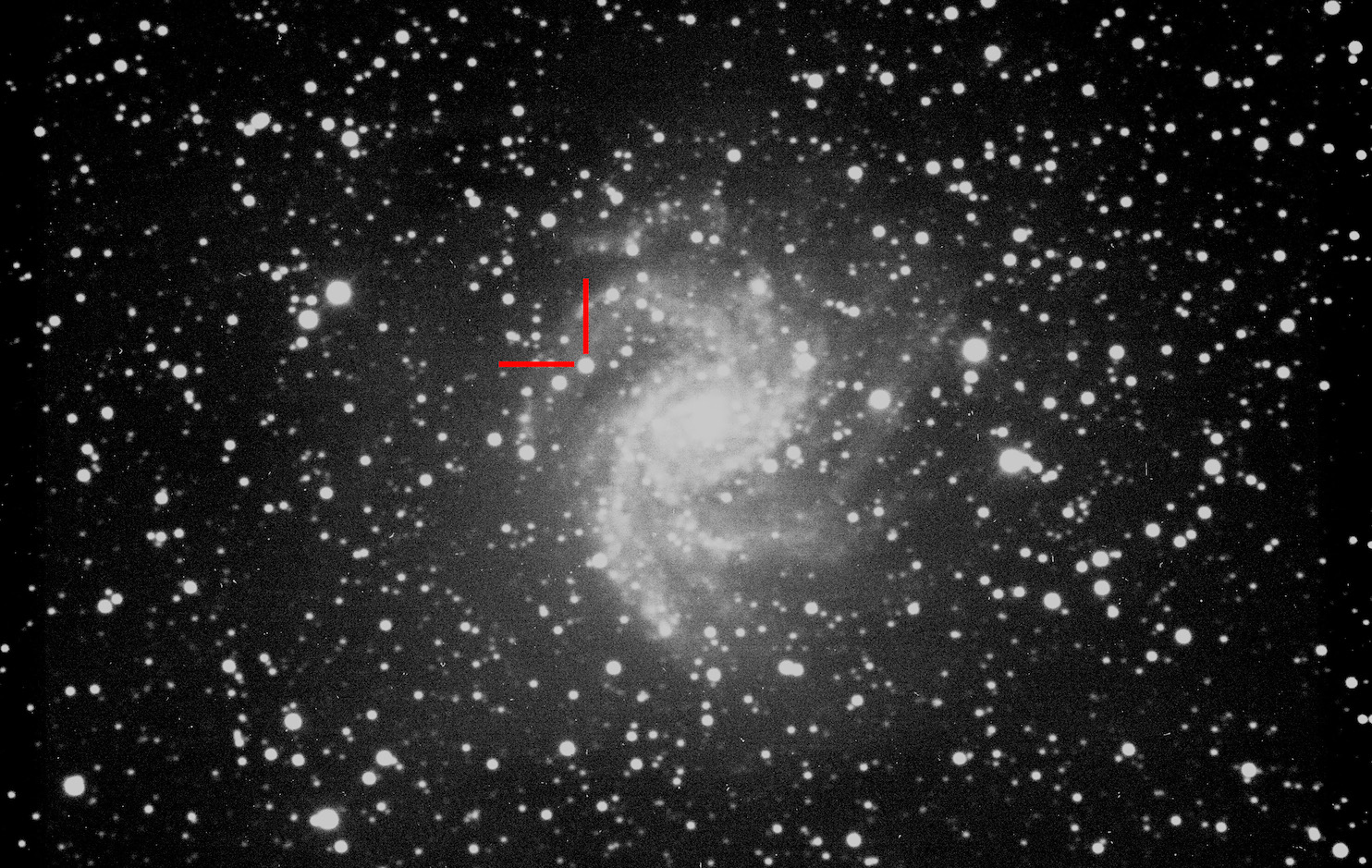
A bright supernova in the Fireworks Galaxy, NGC 6946, a spiral galaxy 22 million light-years away from Earth was discovered on May 14, 2017 by Utah amateur Patrick Wiggins. The size of the galaxy is about one third the size of our own Milky Way Galaxy. The attached photograph taken a few nights later on 05/25/2017 by NFC's Observatory shows two red lines which mark the supernova (where the lines would intersect). The supernova is millions of times farther away than what looks like similar stars. Those stars are foreground stars located in our own galaxy. Astronomers now watch the supernova how it will change in brightness. (Photography by Dr. G. Maresch)
Whirlpool Galaxy
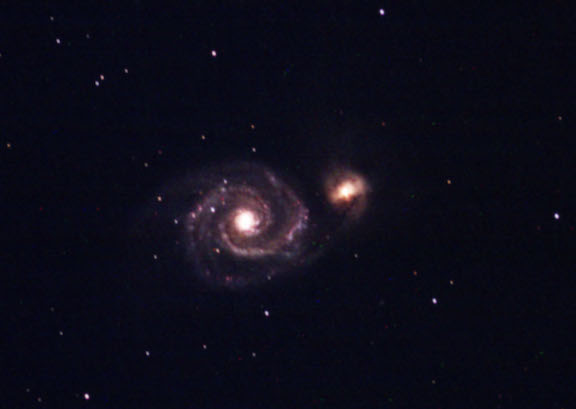
M51, the Whirlpool Galaxy is an interacting spiral galaxy with a Seyfert 2 active galactic nucleus in the Constellation Canes Venatici. M51 is about 23 million light-years from Earth and one of the best known galaxies in the sky. Image acquired on 06/17/2017 (Photography by Dr. G. Maresch)
Why Can't I See Those Beautiful Objects in the Night Sky?
When taking a picture of the night sky with a cell phone it turns out to be mostly black with few if any stars. Our eyes are more sensitive. However we only see the brightest stars with direct vision. Most stars are just too far away to be seen without optical aid.
Yes, You Can!
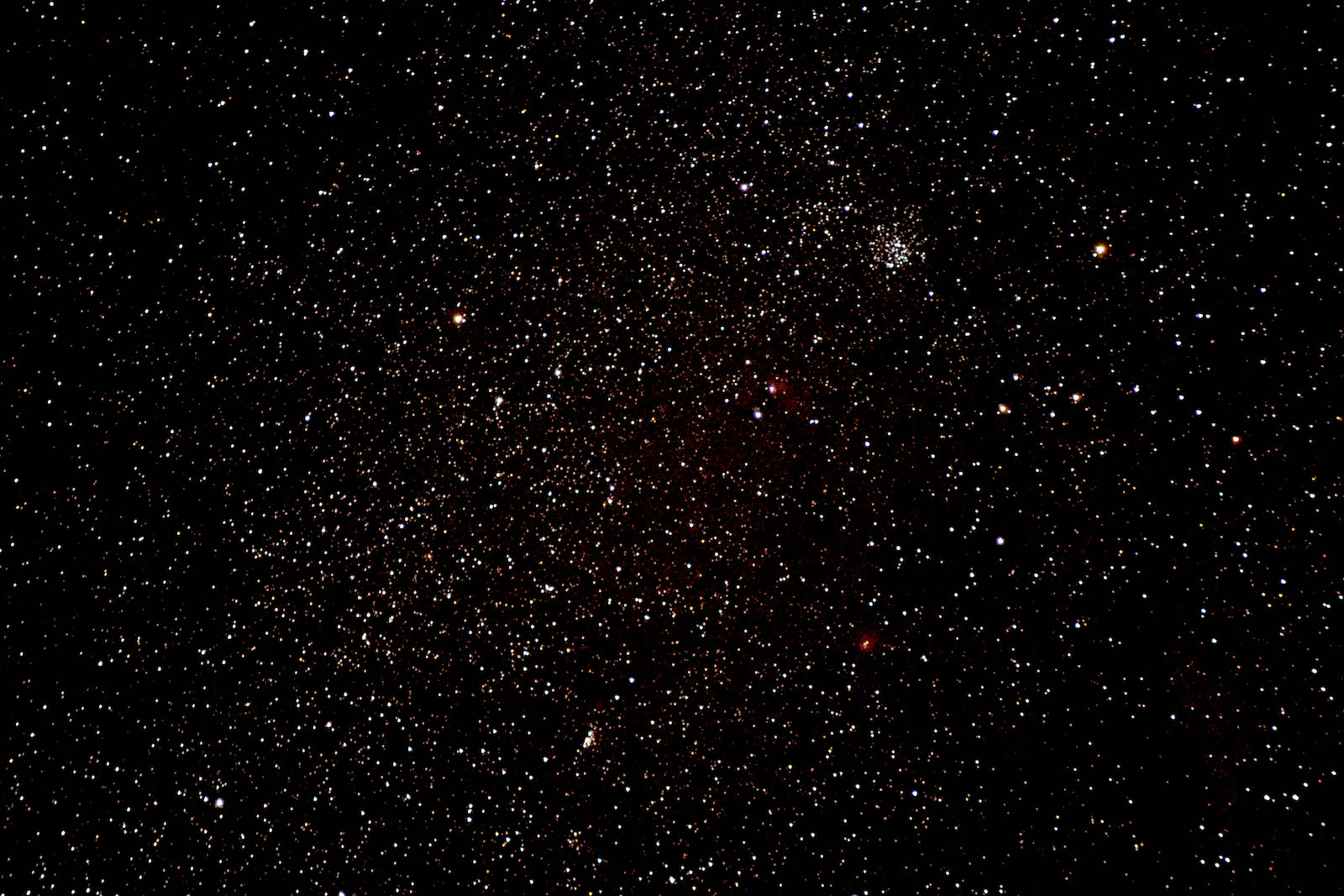
The above image has been taken using a long exposure by a DSLR camera equipped with a 300 mm telephoto lens. Here the problem is: Too many stars! This is due to the fact that the selected region is within the Milky Way Galaxy. Target is the tiny reddish area to the lower left of the star cluster, the Cassiopeia Salt-and-Pepper Cluster, M52, to the upper right in the image.
And Here it is: NGC 7635, the Bubble Nebula
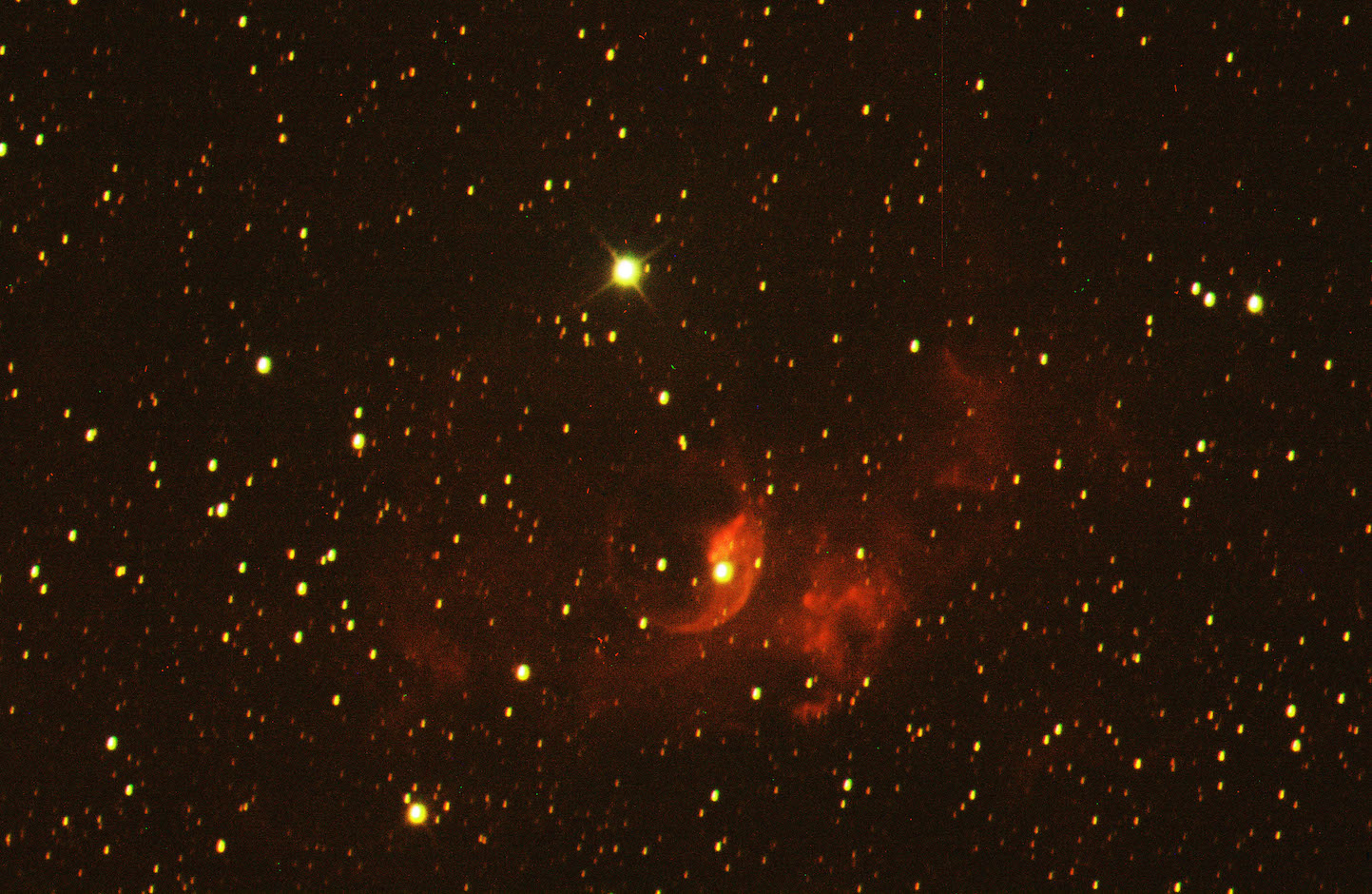
The red clouds are an HII region (interstellar matter consisting of ionized hydrogen atoms) with a young hot star ionizing and heating the hydrogen in an emission nebula. The "bubble" is created by the stellar wind from the massive central star. The nebula is near a giant molecular cloud which glows due to the excitation by the central hot star. The telescope's camera was cooled to -30oC (-22oF), 2 min for each RGB filtered exposure, 12/09/2017. This image was created with the help of ESA/ESO/NASA PhotoShop FITS Liberator. Project Lead: Lars Lindberg Christensen. (Photography by Dr. G. Maresch)
Planet Saturn
Saturn as photographed by members of the Astronomy Club 2017


